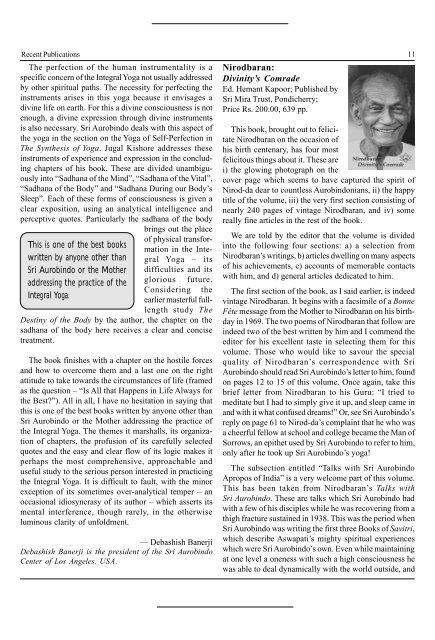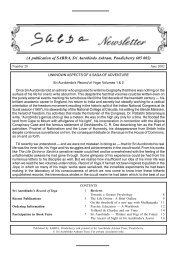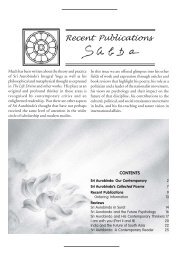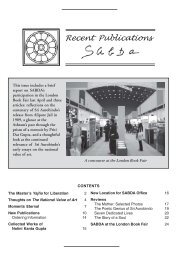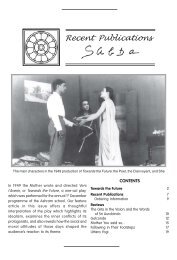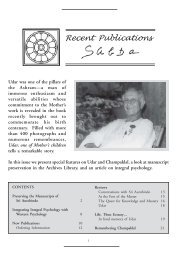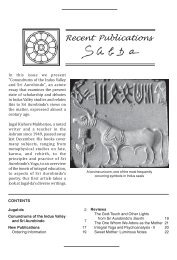Recent Publications - Sabda - Sri Aurobindo Ashram
Recent Publications - Sabda - Sri Aurobindo Ashram
Recent Publications - Sabda - Sri Aurobindo Ashram
Create successful ePaper yourself
Turn your PDF publications into a flip-book with our unique Google optimized e-Paper software.
<strong>Recent</strong> <strong>Publications</strong> 11The perfection of the human instrumentality is aspecific concern of the Integral Yoga not usually addressedby other spiritual paths. The necessity for perfecting theinstruments arises in this yoga because it envisages adivine life on earth. For this a divine consciousness is notenough, a divine expression through divine instrumentsis also necessary. <strong>Sri</strong> <strong>Aurobindo</strong> deals with this aspect ofthe yoga in the section on the Yoga of Self-Perfection inThe Synthesis of Yoga. Jugal Kishore addresses theseinstruments of experience and expression in the concludingchapters of his book. These are divided unambiguouslyinto “Sadhana of the Mind”, “Sadhana of the Vital”,“Sadhana of the Body” and “Sadhana During our Body’sSleep”. Each of these forms of consciousness is given aclear exposition, using an analytical intelligence andperceptive quotes. Particularly the sadhana of the bodybrings out the placeThis is one of the best bookswritten by anyone other than<strong>Sri</strong> <strong>Aurobindo</strong> or the Motheraddressing the practice of theIntegral Yoga.of physical transformationin the IntegralYoga – itsdifficulties and itsglorious future.Considering theearlier masterful fulllengthstudy TheDestiny of the Body by the author, the chapter on thesadhana of the body here receives a clear and concisetreatment.The book finishes with a chapter on the hostile forcesand how to overcome them and a last one on the rightattitude to take towards the circumstances of life (framedas the question – “Is All that Happens in Life Always forthe Best?”). All in all, I have no hesitation in saying thatthis is one of the best books written by anyone other than<strong>Sri</strong> <strong>Aurobindo</strong> or the Mother addressing the practice ofthe Integral Yoga. The themes it marshalls, its organizationof chapters, the profusion of its carefully selectedquotes and the easy and clear flow of its logic makes itperhaps the most comprehensive, approachable anduseful study to the serious person interested in practicingthe Integral Yoga. It is difficult to fault, with the minorexception of its sometimes over-analytical temper – anoccasional idiosyncrasy of its author – which asserts itsmental interference, though rarely, in the otherwiseluminous clarity of unfoldment.— Debashish BanerjiDebashish Banerji is the president of the <strong>Sri</strong> <strong>Aurobindo</strong>Center of Los Angeles, USA.Nirodbaran:Divinity’s ComradeEd. Hemant Kapoor; Published by<strong>Sri</strong> Mira Trust, Pondicherry;Price Rs. 200.00, 639 pp.This book, brought out to felicitateNirodbaran on the occasion ofhis birth centenary, has four mostfelicitous things about it. These arei) the glowing photograph on thecover page which seems to have captured the spirit ofNirod-da dear to countless <strong>Aurobindo</strong>nians, ii) the happytitle of the volume, iii) the very first section consisting ofnearly 240 pages of vintage Nirodbaran, and iv) somereally fine articles in the rest of the book.We are told by the editor that the volume is dividedinto the following four sections: a) a selection fromNirodbaran’s writings, b) articles dwelling on many aspectsof his achievements, c) accounts of memorable contactswith him, and d) general articles dedicated to him.The first section of the book, as I said earlier, is indeedvintage Nirodbaran. It begins with a facsimile of a BonneFête message from the Mother to Nirodbaran on his birthdayin 1969. The two poems of Nirodbaran that follow areindeed two of the best written by him and I commend theeditor for his excellent taste in selecting them for thisvolume. Those who would like to savour the specialquality of Nirodbaran’s correspondence with <strong>Sri</strong><strong>Aurobindo</strong> should read <strong>Sri</strong> <strong>Aurobindo</strong>’s letter to him, foundon pages 12 to 15 of this volume. Once again, take thisbrief letter from Nirodbaran to his Guru: “I tried tomeditate but I had to simply give it up, and sleep came inand with it what confused dreams!” Or, see <strong>Sri</strong> <strong>Aurobindo</strong>’sreply on page 61 to Nirod-da’s complaint that he who wasa cheerful fellow at school and college became the Man ofSorrows, an epithet used by <strong>Sri</strong> <strong>Aurobindo</strong> to refer to him,only after he took up <strong>Sri</strong> <strong>Aurobindo</strong>’s yoga!The subsection entitled “Talks with <strong>Sri</strong> <strong>Aurobindo</strong>Apropos of India” is a very welcome part of this volume.This has been taken from Nirodbaran’s Talks with<strong>Sri</strong> <strong>Aurobindo</strong>. These are talks which <strong>Sri</strong> <strong>Aurobindo</strong> hadwith a few of his disciples while he was recovering from athigh fracture sustained in 1938. This was the period when<strong>Sri</strong> <strong>Aurobindo</strong> was writing the first three Books of Savitri,which describe Aswapati’s mighty spiritual experienceswhich were <strong>Sri</strong> <strong>Aurobindo</strong>’s own. Even while maintainingat one level a oneness with such a high consciousness hewas able to deal dynamically with the world outside, and


